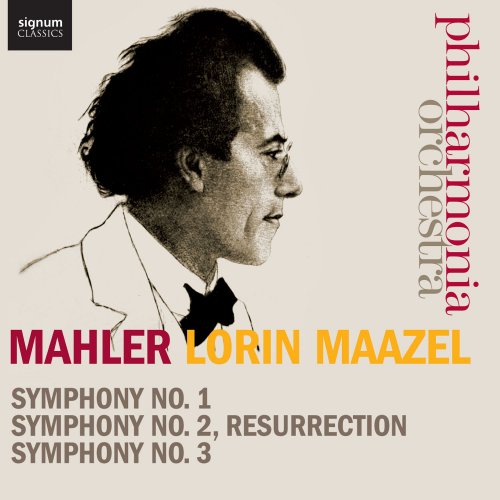Lorin Maazel - Mahler: Symphonies Nos. 1-3 (2013) Hi-Res

Artist: Lorin Maazel
Title: Mahler: Symphonies Nos. 1-3
Year Of Release: 2013
Label: Signum Records
Genre: Classical
Quality: FLAC (tracks) 24bit-44.1kHz
Total Time: 04:14:29
Total Size: 2.4 Gb
WebSite: Album Preview
Tracklist:Title: Mahler: Symphonies Nos. 1-3
Year Of Release: 2013
Label: Signum Records
Genre: Classical
Quality: FLAC (tracks) 24bit-44.1kHz
Total Time: 04:14:29
Total Size: 2.4 Gb
WebSite: Album Preview
Symphony No. 1 (56:57)
1. I. Langsam, Schleppend - Wie Ein Naturlaut 16:26
2. II. Kräftig Bewegt, Doch Nicht Zu Schnell 8:27
3. III. Feierlich Und Gemessen, Ohne Zu Schleppen 11:19
4. IV. Stürmisch Bewegt 20:44
Symphony No. 2 'Resurrection' (1:32:41)
5. I. Allegro Maestoso 25:13
6. II. Andante Moderato. Sehr Gemächlich 11:25
7. III. Scherzo. In Ruhig Fliessender Bewegung 12:14
8. IV. 'Urlicht'. Sehr Feierlich, Aber Schlicht 5:23
9. V. Finale 38:32
Symphony No. 3 (1:46:13)
10. Part 1: I. Kräftig. Entscheiden 37:46
11. Part 2: II. Tempo di Menuetto. Sehr Mässig 11:32
12. Part 2: III. Comodo. Scherzando. Ohne Hast 17:39
13. Part 2: IV. Sehr Langsam. Misterioso 9:10
14. Part 2: V. Lustig Im Tempo Und Keck In Ausdruck 4:15
15. Part 2: VI. Langsam. Ruhevoll. Empfunden 25:51
Performers:
Soprano Vocals – Sally Matthews
Chorus – BBC Symphony Chorus, Tiffin Boys' Choir
Orchestra – Philharmonia Orchestra
Conductor – Lorin Maazel
Mezzo-soprano Vocals – Michelle DeYoung, Sarah Connolly
Previously released as separate CD packages in 2013, this slip-covered set of Gustav Mahler's first three symphonies presents Lorin Maazel and the Philharmonia Orchestra in rather mixed live performances. Because there is serious competition from many superb recordings that are readily available, this reissue from Signum Classics will mostly be of interest to Maazel's committed fans and curious Mahler-obsessives who need to hear every extant recording. Otherwise, listeners can pick and choose. The Symphony No. 1 in D major is a routine reading that brings the work across with no nonsense (thankfully without an interpolation of the rejected "Blumine" movement), yet with no real inspiration either. Indeed, there is a marked sluggishness in Maazel's tempos that suggests either flagging energy or perhaps a lack of imagination or enthusiasm for this over-played work. The Symphony No. 2 in C minor, "Resurrection," is given an exaggerated ponderousness that robs it of any potential for real catharsis, and there is no sense of apocalyptic urgency from Maazel's underwhelming third movement to the perfunctory finale. The most enjoyable of the three performances is the Symphony No. 3 in D minor, which is comparatively free of sluggishness and excessive reverence, and the music feels fresh, vital, and exciting, as if Maazel and the Philharmonia had snapped out of a trance and decided to give the performance their all. Instead of buying this set, listeners should consider acquiring the Symphony No. 3 by itself, and skip the other two recordings.
![Patrick Gibin - Let It Go / Joint Purpose / In This Together (The Joaquin Joe Claussell Remixes) (2025) [Hi-Res] Patrick Gibin - Let It Go / Joint Purpose / In This Together (The Joaquin Joe Claussell Remixes) (2025) [Hi-Res]](https://www.dibpic.com/uploads/posts/2026-01/1767515269_a0142682780_10.jpg)

![Oiro Pena - Oiro Pena (2020) [Hi-Res] Oiro Pena - Oiro Pena (2020) [Hi-Res]](https://img.israbox.com/img/2026-01/04/r18zex2qlhbhk9ouirvlgxcm2.jpg)

![Toc - Quelques idées d’un vert incolore dorment furieusement (2025) [Hi-Res] Toc - Quelques idées d’un vert incolore dorment furieusement (2025) [Hi-Res]](https://img.israbox.com/img/2026-01/03/2p7a6y1mdz29most6p7irqo6y.jpg)


![Elsio Mancuso - The Last Stand (2026) [Hi-Res] Elsio Mancuso - The Last Stand (2026) [Hi-Res]](https://img.israbox.com/img/2026-01/01/9dn870pjrwgwaufih42blfchk.jpg)
